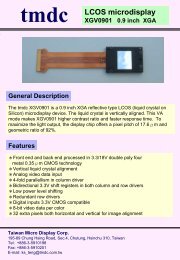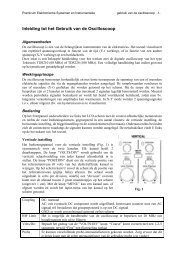Design of LCOS Microdisplay Backplanes for Projection Applications
Design of LCOS Microdisplay Backplanes for Projection Applications
Design of LCOS Microdisplay Backplanes for Projection Applications
You also want an ePaper? Increase the reach of your titles
YUMPU automatically turns print PDFs into web optimized ePapers that Google loves.
Chapter 1 : Welcome to “Display World” CH1 - 25<br />
Chapter 1 : Welcome to “Display World”<br />
T<br />
he target <strong>of</strong> this book is to describe some <strong>of</strong> the issues concerning the design <strong>of</strong><br />
liquid-crystal-on-silicon (lcos) micro-display backplanes. This first chapter<br />
introduces the research topic in more detail. An lcos micro-display backplane<br />
comprises a special chip. Its behavior is much that <strong>of</strong> a programmable slide.<br />
Essentially, it is an electro-optical device; lcos micro-displays are <strong>of</strong>ten referred to<br />
as light valves: electrical signals steer the modulation <strong>of</strong> a beam <strong>of</strong> light in a few<br />
million points. It is useful to place the lcos display case in a broader context and to<br />
try to assess the following questions: is this particular system the display system that<br />
will conquer our houses, is it meaningful to spend research resources to such a<br />
subject and which are the basic principles behind display operation?<br />
The first paragraph <strong>of</strong> this chapter recalls three essential facts about human vision;<br />
three facts that are fundamental to understand the operation <strong>of</strong> most display systems.<br />
The second paragraph briefly mentions economical aspects and gives an indicative<br />
value <strong>of</strong> the "real world" market. After all, what's the practical interest in research on<br />
displays?<br />
The third paragraph is entitled “application specific displays”. It is indeed justified –<br />
to some degree – to state that each display type fits a particular application. A<br />
classification attempt is made to help distinguishing between the several display<br />
technologies, applications, etc, etc. Subsequently, the text focuses on examples <strong>of</strong><br />
liquid-crystal-on-silicon (lcos) projection architectures. Finally, a glance at the<br />
anatomy <strong>of</strong> an lcos micro-display backplane wraps up this chapter and by then<br />
provides more insight in the meaning <strong>of</strong> the thesis’s title… Welcome to display<br />
world!<br />
1.1 How we see colored, moving images<br />
The first paragraph recalls three facts about human vision, essential to understand<br />
the operation <strong>of</strong> any display system.<br />
Today’s state <strong>of</strong> evolution is marked by exchanges <strong>of</strong> increasingly massive<br />
quantities <strong>of</strong> in<strong>for</strong>mation. In this respect, display systems play a prominent role in<br />
everyday communications. But how did mankind come to invent display systems?<br />
Let’s look at some historical facts: some 200 years BC, the famous Aristote noted<br />
how the sun’s image remained visible <strong>for</strong> a while, after turning his eyes away from<br />
it! Around 1650 the ‘magic chamber’ shows up; it is not clear whether it should be<br />
attributed to Athanasius Kircher or Christiaan Huygens. Later, amongst other<br />
discoveries in optics, Joseph Plateau (°1801-†1883) studied ‘phenomena <strong>of</strong> image<br />
CH1 - 25











